After this many years of observing birds carefully I seldom see behaviors that are new to me in common species. But 12 days ago I did.
Bathing in water (as opposed to dust baths) is a common behavior in most birds but I’ve only occasionally seen it in Pied-billed Grebes. I’ve wondered if that’s because they spend so much time diving, although that doesn’t make much sense because ducks and coots often bathe and many of them dive regularly. But it wasn’t just that this grebe bathed that piqued my curiosity – it was how it bathed.
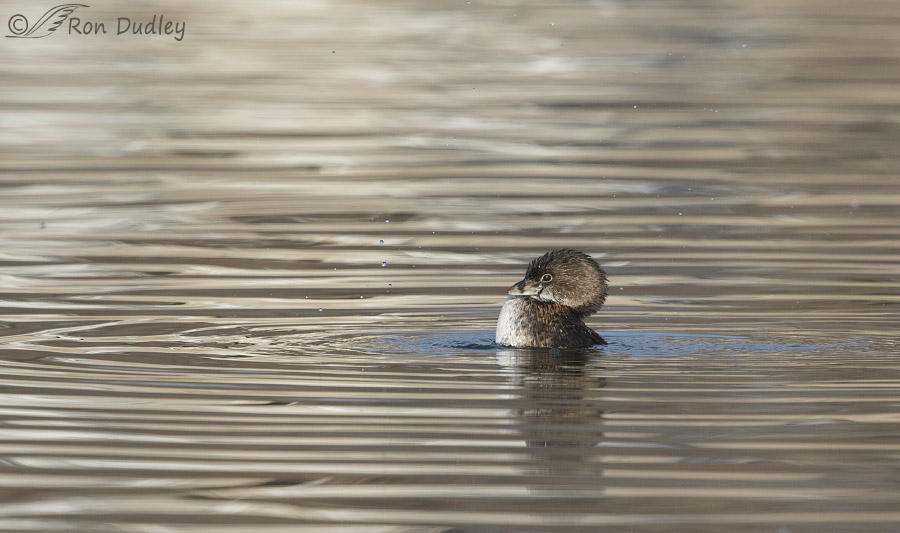
1/2500, f/6.3, ISO 500, Canon 7D Mark II, Canon EF 500mm f/4L IS II USM + EF 1.4 III Extender, not baited, set up or called in
The bird first caught my attention when it raised up in the water and held this unusual half-submerged position for some time. As you can see from the lack of water disturbance there was no bathing activity at this point.
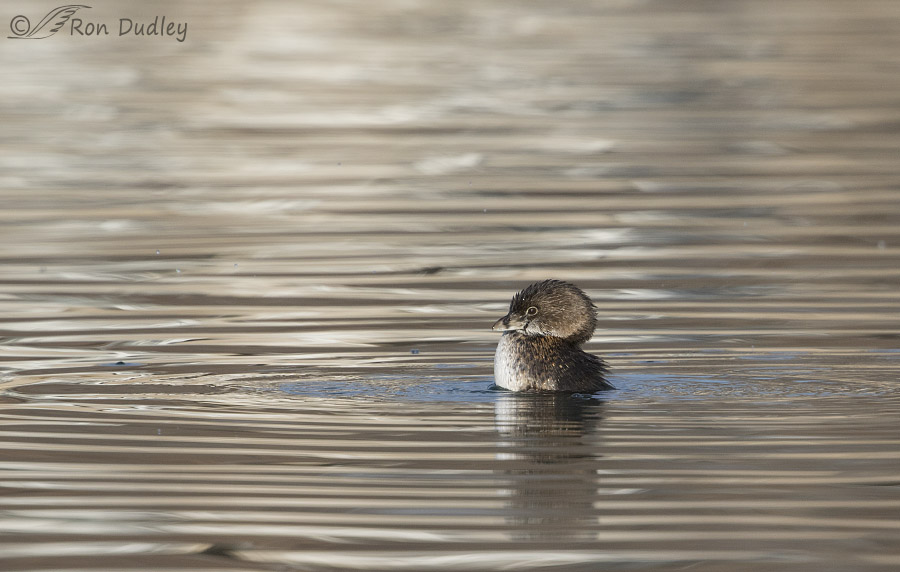
1/2000, f/6.3, ISO 500, Canon 7D Mark II, Canon EF 500mm f/4L IS II USM + EF 1.4 III Extender, not baited, set up or called in
In the next shot (and others) the grebe was still doing the same thing – there is still no bathing activity.
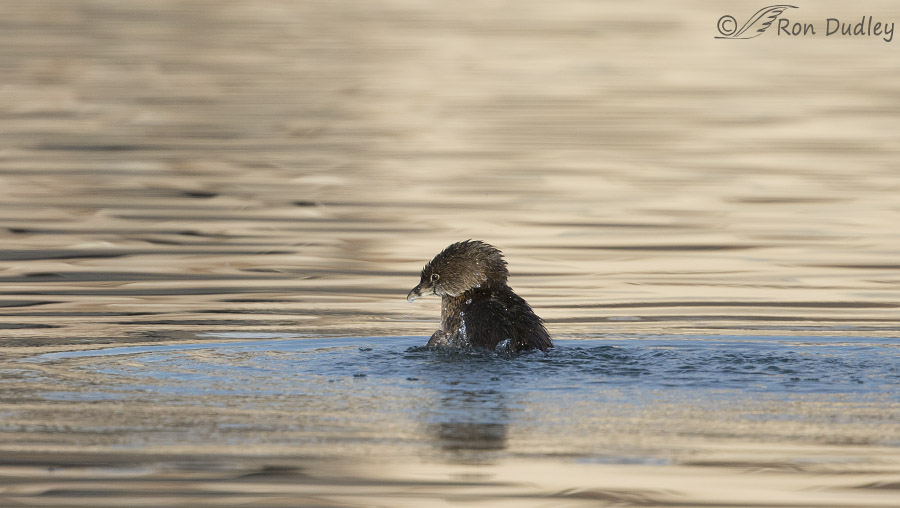
1/2000, f/6.3, ISO 500, Canon 7D Mark II, Canon EF 500mm f/4L IS II USM + EF 1.4 III Extender, not baited, set up or called in
But then, while still in the same unusual position, the bird began to perform what appeared to be high frequency vibrations with its body that sent disturbance out into the water similar to those which might be produced by fairly high frequency sound waves. At this point there was no wing flapping or head bobbing as birds typically do when bathing and it continued to do this for some time. Notice the almost complete lack of true waves or ripples in the water disturbance as we would expect from typical bathing.
I’ve centered the grebe in the frame so more of the water disturbance on both sides can be seen.
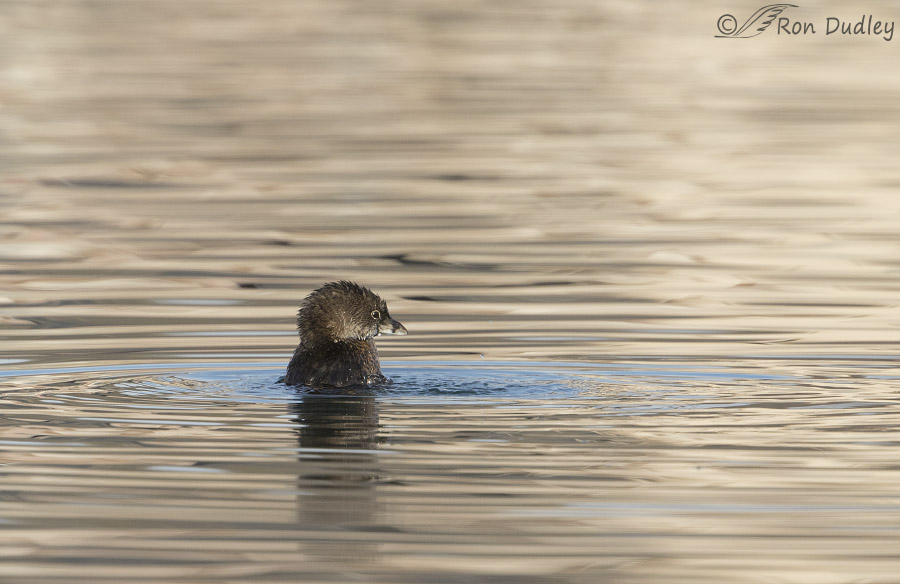
1/1600, f/6.3, ISO 500, Canon 7D Mark II, Canon EF 500mm f/4L IS II USM + EF 1.4 III Extender, not baited, set up or called in
The grebe then slowly rotated its body in the water while continuing to maintain the unusual body position and angle. This shot was taken when there was a near-lull in the vibrations so the water disturbance is less obvious.
Up to this point I didn’t even associate the behavior I was seeing with bathing. I thought something else might be going on.
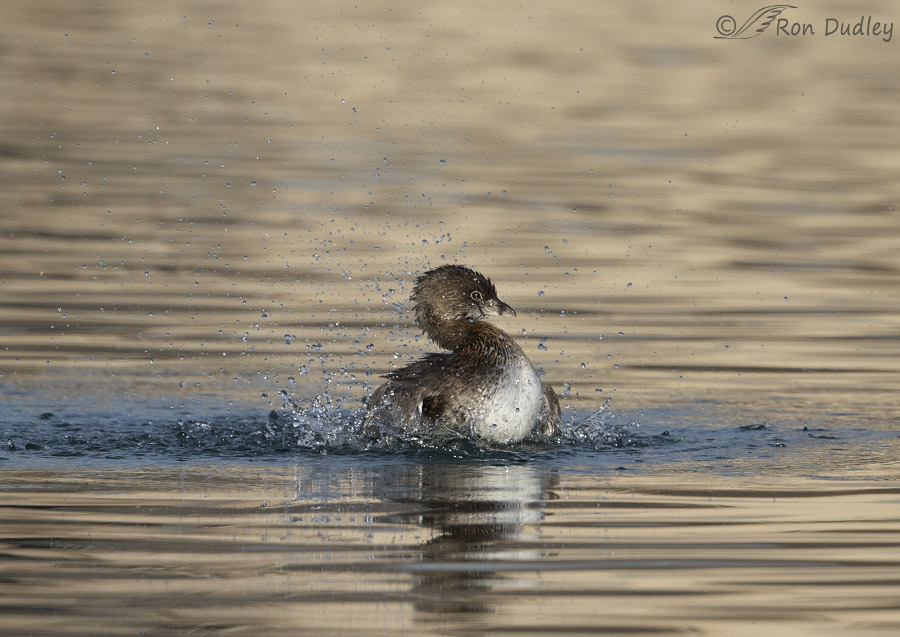
1/3200, f/6.3, ISO 500, Canon 7D Mark II, Canon EF 500mm f/4L IS II USM + EF 1.4 III Extender, not baited, set up or called in
Then the grebe eventually began to bathe more typically by dipping its head into the water and flapping its wings a little to get everything wet. But this didn’t last long before it…
1/2500, f/6.3, ISO 500, Canon 7D Mark II, Canon EF 500mm f/4L IS II USM + EF 1.4 III Extender, not baited, set up or called in
resumed that unusual position and angle in the water again and held it for quite a while. Eventually the bird swam off and resumed normal activities.
Cornell’s Birds of North America Online does mention this species assuming an “upright position in the water, body half-submerged” while bathing but they say the birds flap their half-submerged wings during the process which this bird didn’t do. Neither did it do any head bobbing until much, much later and BNA makes no mention of anything like the “vibrations” that I apparently witnessed.
It’s a little thing, I know and perhaps much ado about nothing. But I may have spent more time with Pied-billed Grebes over the years than I have with any other species and this unique bathing behavior definitely caught my attention because it was so different from anything I’d seen before, from grebes or any other species for that matter.
So I thought some of my readers who are as bird-geeky as I am might be interested in it too. If any of you have witnessed this behavior (“vibration” combined with the unusual half-submerged body angle held for an extended period) I’d appreciate knowing about it. After all, just because I haven’t seen it doesn’t necessarily mean it’s unusual.
Ron


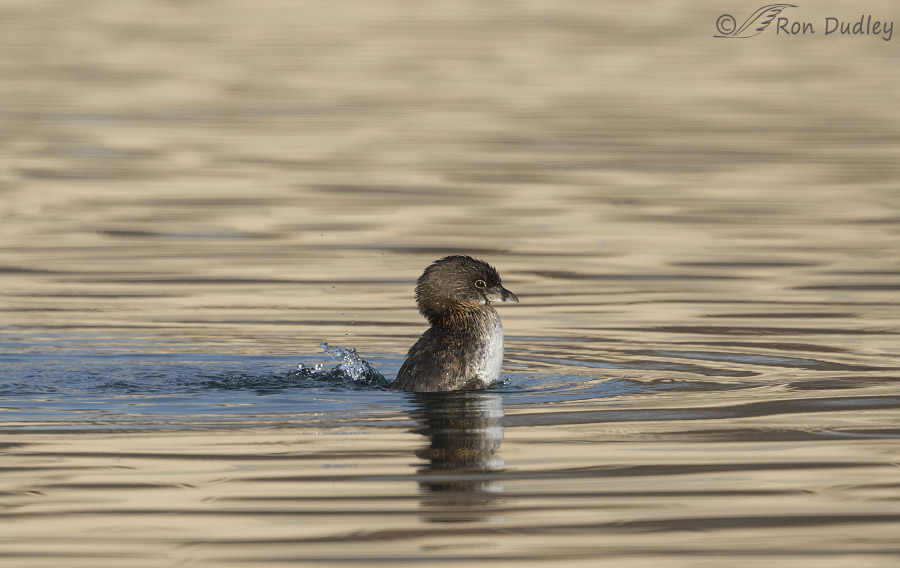
I wrote this yesterday about 7:00 a.m., but it didn’t get sent. Distraction is the bane of my existence these days. Anyway…
Have I mentioned how much I LOVE learning something new every day? WOW! I’d go with the vibrational cleansing idea given that the feather structure of most water birds is pretty darn dense. Thus, they have to work on relaxing that density to release the dirt particles while bathing. That’s just a WAG, but there it is.
Great images and thanks for the images. Yup, I’ve seen it when living on the coast. Watched a grebe do this very similar activity for probably a good 30-40 minutes once because I was so attracted to the behavior. Thought it might be bathing, but was never sure of that fact. Pictures 3 and 5 were what I remember. Back than I attributed it specifically to Pied-billed Grebes, never saw that type of behavior with any other species.
So stinkin’ cool! You do manage to catch birds doing the strangest things.
Of course, there are other bodily activities that could cause those bubbles… (Sorry, I’ll show myself out now.)
Ha, I think we both spent too much time in the classroom, Marty!
Fascinating. And probably very effective too. Now you have me wondering why it isn’t more common, and where this particular grebe learned it from.
My guess is that it’s instinctive, EC. But I am surprised that more birds don’t do it. Perhaps it’s a function of size of the bird and the physics of feather movement… ?
Very interesting!! I have not seen this behavior. Of course I’ve never seen a pied-billed Grebe, so we’ll take that into account Just a couple of years into this fascinating avocation and I learn something new everyday!
Just a couple of years into this fascinating avocation and I learn something new everyday!
“I learn something new everyday”
On many days I do too, Joanne. If not from my observations of birds or my own photos it’s from readers of my blog.
Strange…ultrasonic cleaning is used to clean drawing ink pens and jewely, but a self-cleaning dirty “duck” is something new….very interesting…..
Patty, it’s just possible that’s almost exactly what’s happening. If it works for pens and jewelry why wouldn’t it work on a little slower speed with a bird? It’s isn’t really “ultrasonic” (because the ripples aren’t caused by sound) but it seems to me that the effect would be about the same. And after all, that’s the purpose of bathing – cleaning.
That possiblity is so darned intriguing!!!
I agree.
I’ve seen this behavior in pied-billed grebes here, a few times – I have a photo of it from 2016, I think – but I never thought about why the grebe was doing it. Just adding a data point here – yes, I have observed this behavior probably 3 times.
Interesting to know, Martha. Thank you.
Back in the day, we used an ultra-sonic cleaner to remove dried ink and clogs from our fine, hollow tipped drawing pens. It was basically a vibrating bath full of cleaning solution that we submerged the disassembled pen into over night. Not the same, I know. But an effective cleaning and maintenance regime using the power of vibration to do the fine work.
“Not the same, I know”
They’re close enough for me to make the comparison, Robert. Sound vibrations in the water was the best thing I could think of to compare it to.
That is strange and interesting……..trying to warm itself perhaps? Glad you captured the behavior!
I am too, Judy – even though I wasn’t particularly close to the grebe when it happened.
Ron – I have seen American Coots do this same maneuvering. When a predator (usually a Bald Eagle) is flying low over the water. They will gather into a large group and begin this water splashing vibration routine. I have not seen PB Grebes do this defensive move. Nice photos as usual. Thanks for sharing.j
Interesting that you’ve seen it in coots, Mark. I never have. I never considered that it might be a defensive maneuver and in this case my guess is that it isn’t because it was associated with typical bathing behavior that came very soon after. I don’t think they’d bathe so soon after feeling threatened…
I believe that it was using essential Water Arobics sequence of movements similar to the “bubbling hands” we use to tone arm muscles….water bubbles up differently during these maneuvers. Now, back to shoveling maneuvers-but still not much snow here in NE Illinois.
I like creative theories, Diane…